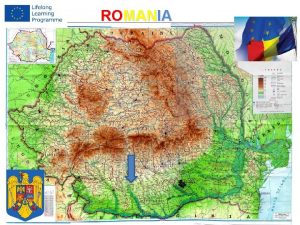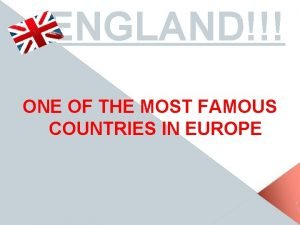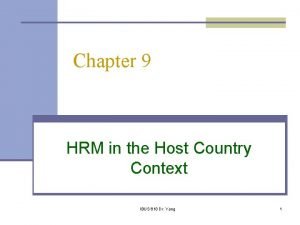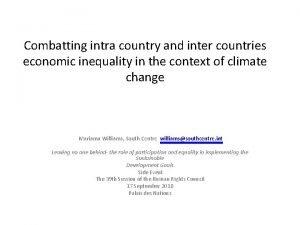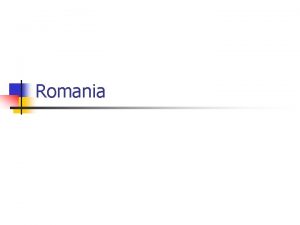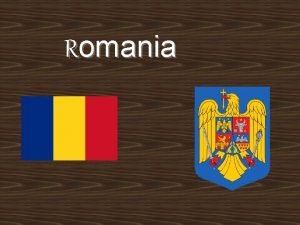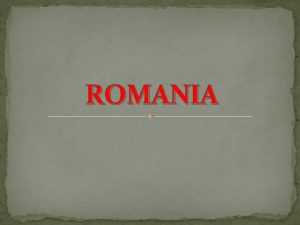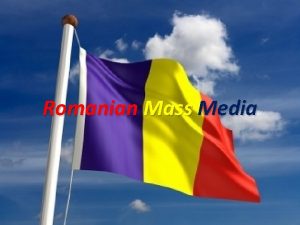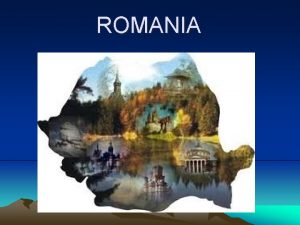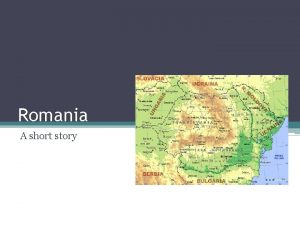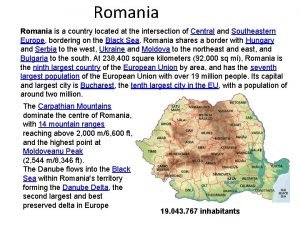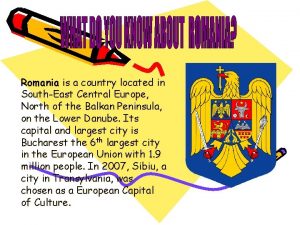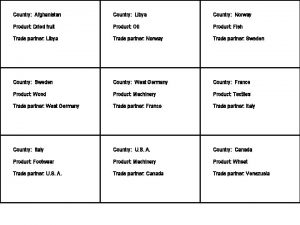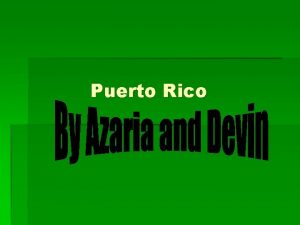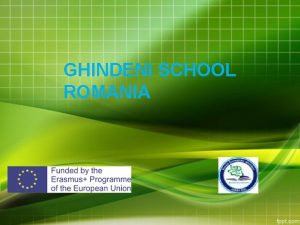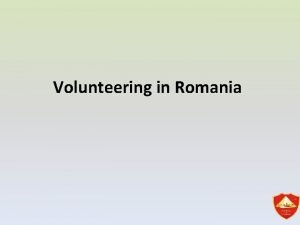ROMANIA Romania is a country located at the

















- Slides: 17

ROMANIA

Romania is a country located at the intersection of Central and Southeastern Europe, bordering on the Black Sea. Romania shares a border with Hungary and Serbia to the west, Ukraine and Moldova to the northeast and east, and Bulgaria to the south. Etymology • Romania derives from the Latin romanus, meaning "citizen of Rome". Language • The official language of Romania is Romanian, a Latin language related to Italian, French, Catalan, Spanish and Portuguese. This project has been funded with support from the European Commission. This publication reflects the views only of the author, and the Commission cannot be held responsible for any use which may be made of the information contained there in.

BUCHAREST, THE CAPITAL CITY Government • Romania is a semi-presidential republic where executive functions are held by both government and the president. The president is elected by popular vote for a maximum of two terms, and since the amendments in 2003, each term lasts five years. The Parliament Palace This project has been funded with support from the European Commission. This publication reflects the views only of the author, and the Commission cannot be held responsible for any use which may be made of the information contained there in.

• Romania is the eighth largest country of the European Union by area, and has the seventh largest population of the European Union. • Its capital and largest city is Bucharest – the sixth largest city in the EU. This project has been funded with support from the European Commission. This publication reflects the views only of the author, and the Commission cannot be held responsible for any use which may be made of the information contained there in.

The Triumphal Arch located in the northern part of Bucharest, on the Kiseleff Road. The current arch has a height of 27 metres and was built after the plans of the architect Petre Antonescu. The sculptures with which the facades are decorated were created by famous Romanian sculptors such as Ion Jalea and Dimitrie Paciurea. This project has been funded with support from the European Commission. This publication reflects the views only of the author, and the Commission cannot be held responsible for any use which may be made of the information contained there in.

THE CARPATHIANS The Carpathians consist of a chain of mountain ranges that stretch in an arc from the Czech Republic (3%) in the northwest through Slovakia (17%), Poland (10%), Hungary (4%) and Ukraine (11%) to Romania (53%) in the east and on to the Iron Gates on the River Danube between Romania and Serbia (2%) in the south. The Carpathians and their piedmont also concentrate many thermal and mineral waters, with Romania having over one-third of the European total. This project has been funded with support from the European Commission. This publication reflects the views only of the author, and the Commission cannot be held responsible for any use which may be made of the information contained there in.

This project has been funded with support from the European Commission. This publication reflects the views only of the author, and the Commission cannot be held responsible for any use which may be made of the information contained there in.

THE DANUBE DELTA This project has been funded with support from the European Commission. This publication reflects the views only of the author, and the Commission cannot be held responsible for any use which may be made of the information contained there in.

The Danube Delta is the second largest river delta in Europe, after the Volga Delta. The approximate surface is 4, 152 km², of which 3, 446 km² are in Romania. This project has been funded with support from the European Commission. This publication reflects the views only of the author, and the Commission cannot be held responsible for any use which may be made of the information contained there in.

THE BLACK SEA COAST It is bounded by Europe, Anatolia and the Caucasus and is ultimately connected to the Atlantic Ocean via the Mediterranean and the Aegean Seas and various straits. Mediterranean water flows into the Black Sea as part of a two-way hydrological exchange. This project has been funded with support from the European Commission. This publication reflects the views only of the author, and the Commission cannot be held responsible for any use which may be made of the information contained there in.

The Romanian educational system consists of four levels of studies. These levels are kindergarten, primary, secondary and higher education. As per the educational guidelines as set forth by the Ministry of Education and Research, kindergarten is optional for children aged three to six. Primary school begins when the child age is six or seven. This level of education is obligatory until the tenth grade. The next phase is higher education and is also an optional phase of education. • Kindergarten • The kindergarten level is an optional one and is available for children as young as three years old until they reach six or seven years old. • Elementary or Primary School • Public schools offer free education, but textbooks and some school materials like pencils, notebooks and uniforms may need to be separately purchased. This project has been funded with support from the European Commission. This publication reflects the views only of the author, and the Commission cannot be held responsible for any use which may be made of the information contained there in.

School Year The school year begins on the month of September and ends in June of the following year. The school year is divided into two semesters, the first one from September to January and the second one from February to June. Grading Systems – Lower Levels The first four years of elementary school follows a system called the calificative. There are four grades. Foarte Bine or FB corresponds to Excellent, Bine or B for Good. Satisfacator/Suficient or S for Satisfactory (which connotes a barely passing grade) and Nesatisfăcător/Insuficient or I for failed marks. Grading Systems – Upper Levels A different grading system is used for upper elementary levels. Grades 5 to 12 use a 1 to 10 grading system, with one being the lowest grade and 10 being the highest. • High Schools • After the 8 th grade, students are required to take the Testarea Naţională or the National Test. This is a nationwide examination that can only be taken once. The subjects included in the test are Romanian Language and Literature and Maths. This project has been funded with support from the European Commission. This publication reflects the views only of the author, and the Commission cannot be held responsible for any use which may be made of the information contained there in.

SLATINA Slatina is the capital city of Olt County, on the river Olt. The city administers one village, Cireaşov. The town of Slatina was first mentioned on January 20, 1368. Alro Slatina, the largest aluminum producing factories in Southeastern Europe, is located in the city. Other companies based in Slatina include ALPROM (which, like ALRO, is a subsidiary of VIMETCOGROUP), Altur (engine set manufacturer), Pirelli Tires Romania (tire-manufacturer), Cord Romania (steel cord for tires), TMK Artrom (seamless steel tubes), Prysmian (electronic and electric wires and cables). This project has been funded with support from the European Commission. This publication reflects the views only of the author, and the Commission cannot be held responsible for any use which may be made of the information contained there in.

This project has been funded with support from the European Commission. This publication reflects the views only of the author, and the Commission cannot be held responsible for any use which may be made of the information contained there in.

This project has been funded with support from the European Commission. This publication reflects the views only of the author, and the Commission cannot be held responsible for any use which may be made of the information contained there in.

METALURGIC TECHNICAL HIGH SCHOOL Number of students: 1243 Number of teachers: 66 Fields of education: - Industrial Chemistry - Protection of environment - Mechanics - Electronics - Transport Our school has partnerships with local agents mentioned on the previous slide as for students to practice their skills. Endowment: - Library - School canteen - School hostel - 9 Labs - Gym This project has been funded with support from the European Commission. This publication reflects the views only of the author, and the Commission cannot be held responsible for any use which may be made of the information contained there in.

THANK YOU FOR YOUR TIME! This project has been funded with support from the European Commission. This publication reflects the views only of the author, and the Commission cannot be held responsible for any use which may be made of the information contained there in.
 Is romanian a latin language
Is romanian a latin language Sistine chapel is located in which country
Sistine chapel is located in which country Poland is located in which country
Poland is located in which country England is located in which country
England is located in which country The mycenaeans were located in this country.
The mycenaeans were located in this country. Host country and home country
Host country and home country Intra country vs inter country
Intra country vs inter country Thế nào là hệ số cao nhất
Thế nào là hệ số cao nhất ưu thế lai là gì
ưu thế lai là gì Sơ đồ cơ thể người
Sơ đồ cơ thể người Tư thế ngồi viết
Tư thế ngồi viết Các môn thể thao bắt đầu bằng tiếng nhảy
Các môn thể thao bắt đầu bằng tiếng nhảy Cái miệng bé xinh thế chỉ nói điều hay thôi
Cái miệng bé xinh thế chỉ nói điều hay thôi Hình ảnh bộ gõ cơ thể búng tay
Hình ảnh bộ gõ cơ thể búng tay Mật thư tọa độ 5x5
Mật thư tọa độ 5x5 Tư thế ngồi viết
Tư thế ngồi viết Chó sói
Chó sói Thẻ vin
Thẻ vin
